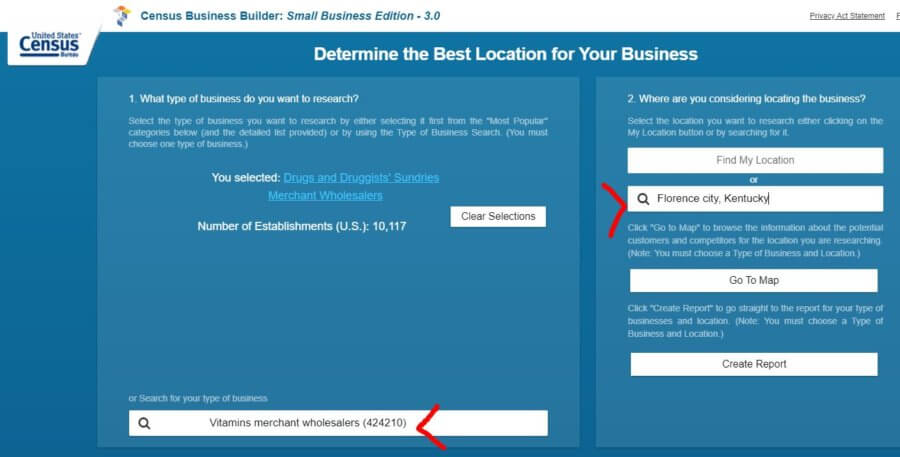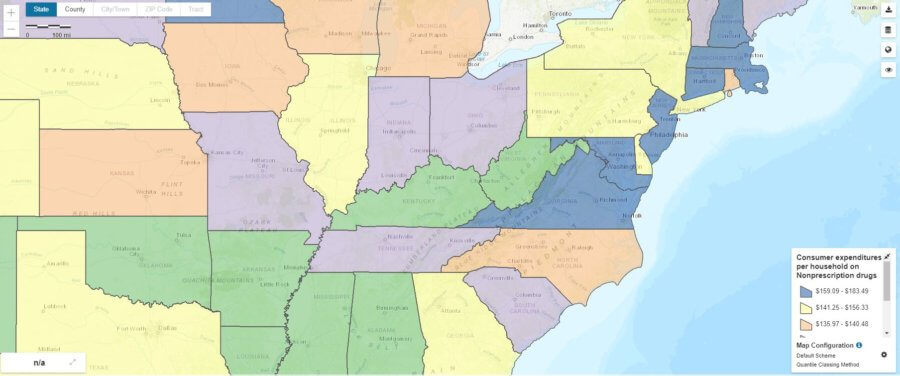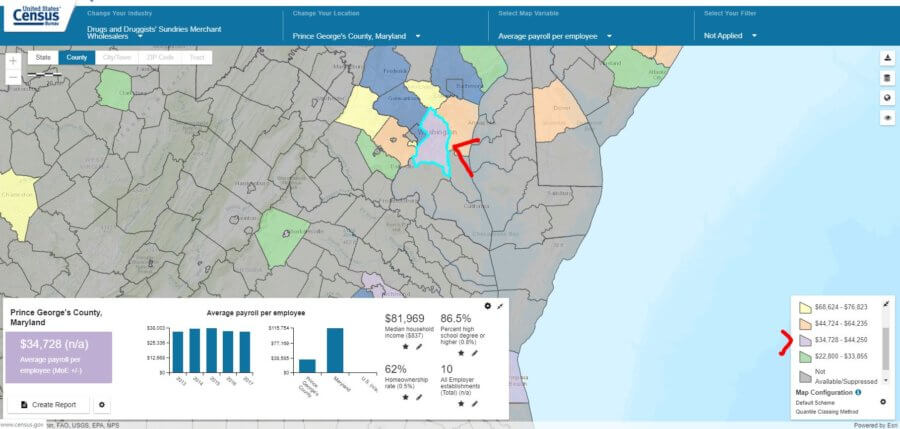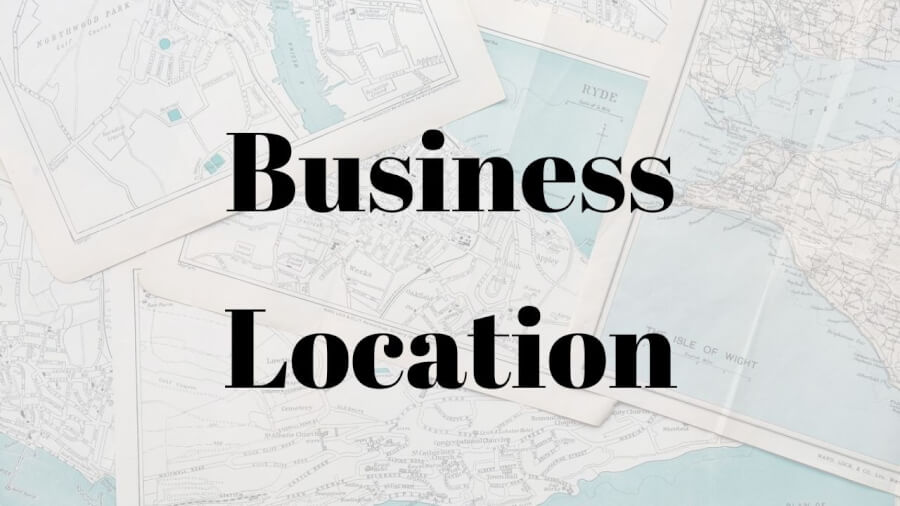The Census Business Builder is a great tool to narrow down possible locations for your business. But, there are other important factors to consider like cost, competition, and capacity.
Why is location analysis important?
Location, location, location. This is often cited as the three most important factors in real estate. They’re also important for your small business too. Particularly if it’s a business that sells to the general public.
If your business doesn’t sell to the public though, that doesn’t mean that location doesn’t matter. You also have to consider your distance from customers, infrastructure, and other not so obvious things that can have an impact on sales and profit.
A business location analysis isn’t just important for your first location either. Yes, that might be the most important location analysis you undertake. But, it’s also important for your second, third,… whatever location.
So, what is a business location analysis?
It’s simply the gathering of location-related information, compiling it, and making the best decision you can. It may not be the optimal decision – which is okay. There are a lot of variables that affect the quality of a location. Probably more than you or I am capable of completely wrapping our heads around.
It is important to put your best foot forward though. If you give a business location analysis its time, you should make a good decision. Making a bad decision can result in costs (ownership or leasing) that are too high to support your level of business.
Remember, fixed costs aren’t necessarily bad. High lease payment can make sense if you’re in a location that’s going to make a lot in sales. Refer to this post on operational leverage to learn more.
A location analysis is vital for your business plan
Those who review your business plan are probably going to know how important location is. So, if you want to raise additional capital, or get a loan, you’ll need to address this important fact. You’ll need to make it clear how your location is going to contribute to your small business’s success.
Be prepared to answer why you’re choosing the location you are. what effect is this location going to have on your success? Take advantage of the tools available and consider the necessary factors. If you do, you’ll be able to confidently back up your location decision.
Factors to consider when doing site selection
Demographics of the area
When you think of demographics you typically think of descriptors for individuals. For example gender, income, age, homeownership, etc. Information like that is important, of course, if you’re relying on those individuals. Relying on them to purchase your products/services or to help sell them.
But, businesses also have demographics. So, if your small business is selling other businesses (B2B) – then you want to know the demographics of the nearby businesses too.
The competition
Where are your competitors located? Are they nearby? Or, are they in a completely different location? What advantages and disadvantages does their location have compared to yours? Do they know something you don’t? Or, maybe they didn’t think it through enough?
Nearby traffic
Traffic plays an important part in a business location analysis. If you’re selling to the people in those cars, and then you probably want to see more of them. That is, given that the local infrastructure can handle that volume of traffic. If it’s difficult to get in and out of your business, then all that traffic might be a deterrent for your customers.
Traffic also affects your employees. Depending on your geographic location, people’s tolerance for traffic might be different. If your location is going to be in a major metropolitan area, a lack of traffic might serve as something of an incentive to potential employees. If your location is going to be in a lesser metropolitan area, then being near the most congested traffic in the city might serve as a deterrent.
The local economy
Even if your business is based online, and you have minimal needs in terms of employees – the health of the local economy will still have a bearing on your business. Consider the economic implications of the different locations you’re reviewing.
Your business’ initial and ongoing location costs
As mentioned before, you need to make sure that the location you choose represents a good return on investment (ROI). Keep in mind what the initial location costs might be. So that you don’t spend too much before you’re even able to utilize the location.
Of course, you want to be cognizant of the ongoing location costs too. What the fixed costs will be and how they will affect your breakeven point and degree of operating leverage.
Will the location make business easier?
A lot of business revolves around the “numbers” making sense. But, there are human beings behind all those numbers. You being one of them. The best return on investment in the world probably isn’t worth it if it makes you, your employees, or your customers, miserable.
So, think about the intangibles. Don’t just quantify your analysis. Qualify it to.
Look at it from your employees’ perspective.
On the same token, how will the people working at this location feel about it? I mentioned traffic earlier, but there’s more to consider from the employees’ perspective. Are there places to eat nearby? Is this a part of town that employees will want to travel to?
Really try to look at this through your employees’ eyes. They don’t reap the same benefits that you, as an owner, do. If you were an employee, would you want to drag yourself to a job at this location day in, day out, year after year?
Adequate space and capacity considerations
It goes without saying that you need a building that facilitates the nature of your business. If you need warehouse space you’ll probably need loading docks. Or, doors that are big enough to drive a forklift in and out of.
If you have a computer-intensive business, you want to make sure that it has the broadband capability as you need.
Keep in mind, that you wanna look a bit into the future here. Don’t just think about what your needs are today or tomorrow, think about your best-case scenario. If your business grows faster than you anticipate, are you going to have the capacity to handle that level of business? Of course, don’t overspend just have a lot of excess space. Think of it as a balancing act.
An example of location analysis
As with most of my business plan related posts, I like to include an example. Previously, I had used my own aspiring business as an example. This business involves the manufacture and distribution of a topical hair thickening treatment.
I’ll rely heavily on the Census Business Builder (CBB) to narrow down a location. From there, potential locations can be qualified with some of the factors mentioned above.
Here’s a post I wrote on navigating the CBB.
Finding a location for a distribution center
As I mentioned in my Market Size for a Business Plan post, I would initially plan on outsourcing manufacturing. But, even though I’m not choosing where to locate a manufacturing facility, I may still need a location for distribution.
One of the potential manufacturers I found was in Florence, KY – which is near Cincinnati, OH.
So, on the CBB homescreen, I enter my NAICS code: 424210. Not because I’ll need it, in this instance, but because it’s required to get the map to come up. Then, I’ll enter Florence, KY as my location.

Next, I’ll Select a Map Variable that will help in my search. My first thought is that I want my distribution center to be relatively close to the bulk of my customers – though I plan to eventually ship nationwide. This should help to keep shipping expenses down. So, I’ll use Consumer expenditures per household on Nonprescription drugs as my Variable.
I’ll also expand my geography out to the State level. I want to start broad and then narrow down.

As you can see, with the map centered around Cincinnati, the states represented in blue are those in the top quintile of spending on nonprescription drugs. Almost all of them stretch up the Northeast coast.
With that knowledge, I might start looking in Virginia. The closest of the high-spending states. Virginia is also, relatively speaking, closer to the West coast than the other states.
If I zoom in on Virginia and change my geography to County, I can narrow down further. Many of the counties are around the Richmond area and in Northern Virginia, close to Washington D.C.
What I’ll also do here is change my Map Variable. There isn’t one that details the average cost per sq ft of warehouse space (unfortunately). So, I’ll have to use something else.
I’ll use Average payroll per employee. I don’t want to hire just anyone, but I do want to keep costs manageable. So, I’ll focus on the second-lowest quintile ($34.7K – $44.3K).
Viola! I found it! Prince George’s County, Maryland will serve as a valid starting point for searching for a distribution center for my product. It’s not in Virginia, but it does seem to meet all of my initial requirements.

From here, I would search the web for available warehouse space and would qualify the choices with the factors listed above.
If I found another potential manufacturer, I could apply the same rationale to find more location options. Or, I could apply a completely different rationale. The steps I used to arrive at this location were just the first to come to mind. They aren’t necessarily the best.
Address potential problems with your business location
It’s best to get out in front of potential problems with your location. Just as it’s important to acknowledge your weaknesses and threats when doing a swot analysis. Think about how you’re going to handle your location’s shortcomings. Nearly every location has some.
Additionally, you want to acknowledge where your competitors are at. Consider the advantages and disadvantages of their locations.
Also, think about the best-case, most likely, and worst-case scenario. Just as I suggest you do with your annual budgeting.
How are you going to take advantage of the location? How are you going to overcome the shortcomings of your location?
Avoid picking a location just because it seems like a bargain. There’s more to consider than just the rent. Like almost everything in business, at the end of the day, it’s about the return on investment.

